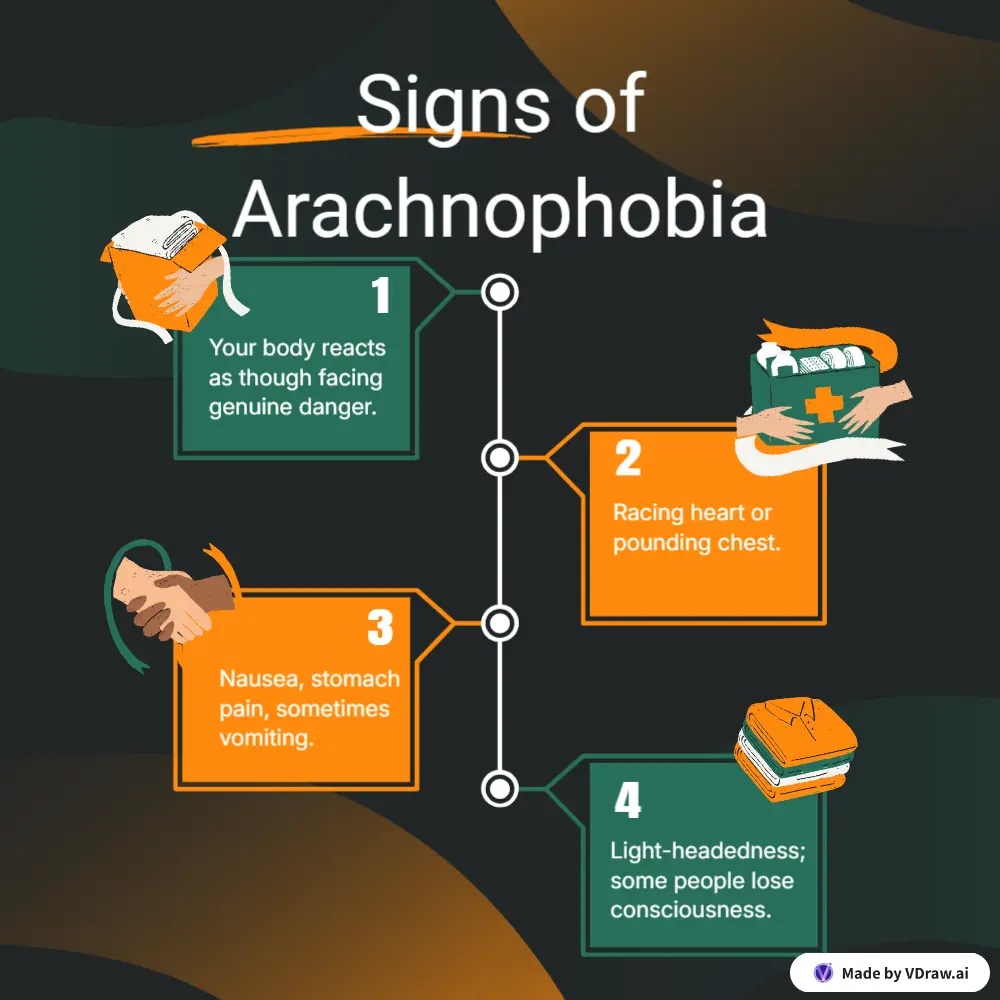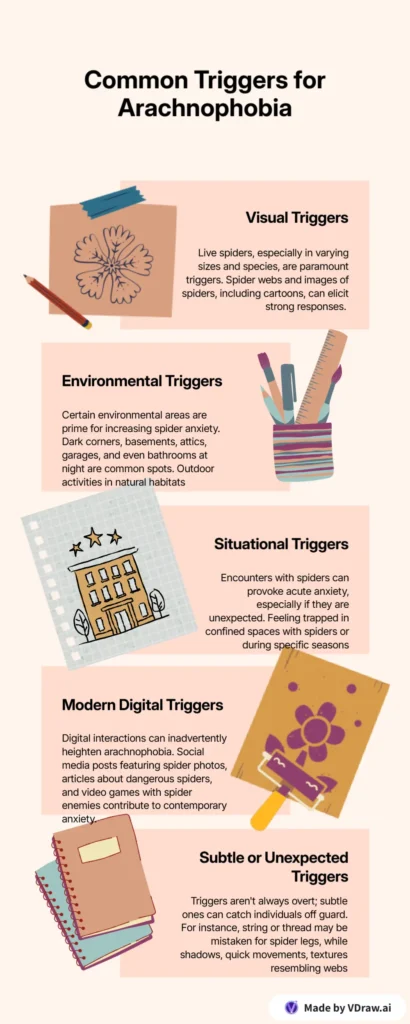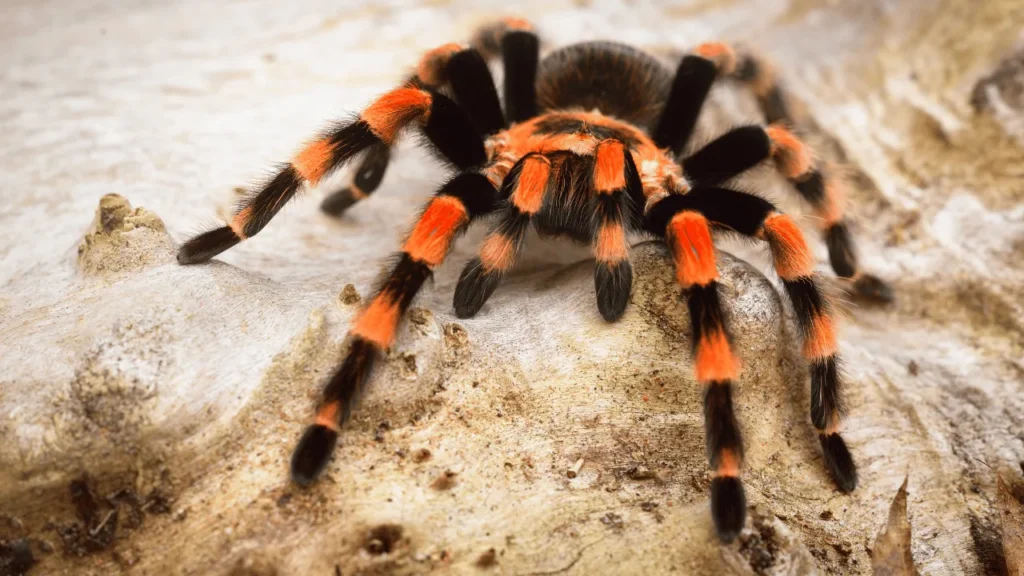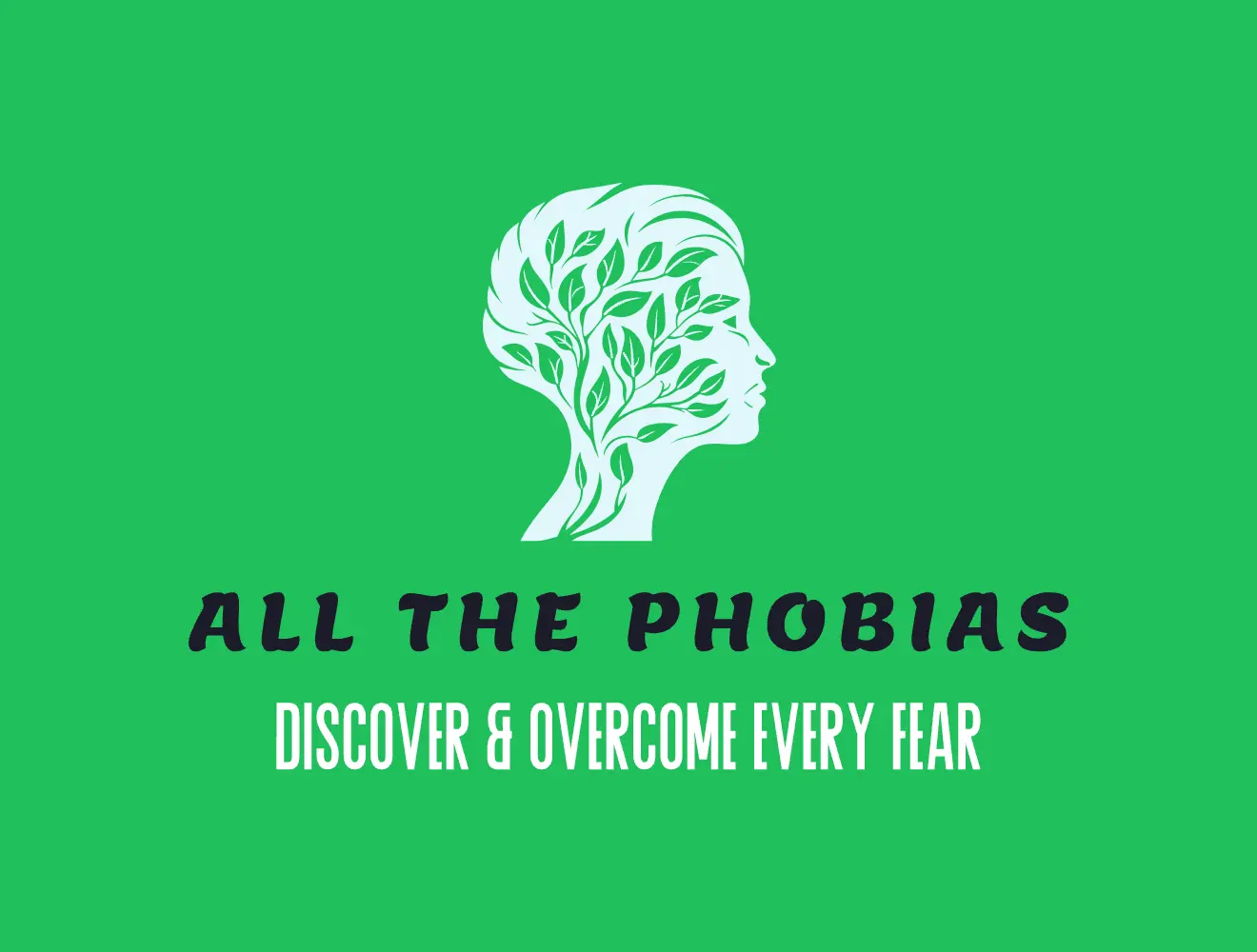What is Arachnophobia? {#what-is-arachnophobia}
Arachnophobia derives from the Greek words “arachne” (spider) and “phobos” (fear), describing an intense, overwhelming fear of spiders that extends far beyond typical discomfort.
The Critical Difference: Normal Fear vs. Phobia
Most people experience mild unease around spiders—a momentary startle, perhaps some discomfort, then they move on. Arachnophobia triggers your body’s complete fight-or-flight response, flooding your system with stress hormones even when thinking about spiders.
You’re Not Alone: The Numbers
Arachnophobia affects between 3% and 15% of the global population, making it one of the most prevalent specific phobias worldwide.[^1] That translates to millions of people sharing your experience. You’re neither “crazy” nor “weak”—you’re experiencing a legitimate anxiety disorder that deserves proper understanding and treatment.
Why Spider Fear Feels Different
Unlike phobias triggered only in specific situations (like fear of flying), spiders can appear anywhere: your home, workplace, car, or favorite outdoor spaces. This ubiquity makes arachnophobia particularly overwhelming and difficult to avoid.
Important perspective: As both a psychologist and someone who has personally overcome this fear, I want you to understand that having arachnophobia reflects nothing about your character or strength. It’s a treatable condition that responds well to proper intervention.
Recognizing the Signs and Symptoms {#signs-and-symptoms}
Arachnophobia manifests through three interconnected symptom categories. You might experience some or all of these responses:
Physical Symptoms: Your Body’s Alarm System
When confronting spiders, your body reacts as though facing genuine danger:
- Cardiovascular responses: Racing heart or pounding chest (heart rate can spike from resting to 100+ BPM instantly)
- Perspiration: Excessive sweating, particularly on palms, face, or entire body
- Trembling: Uncontrollable shaking in hands, legs, or throughout your body
- Respiratory distress: Difficulty breathing, feeling suffocated or unable to catch your breath
- Gastrointestinal upset: Nausea, stomach pain, sometimes leading to vomiting
- Dizziness or fainting: Light-headedness; some people actually lose consciousness
- Muscle tension: Body feels rigid, frozen, or locked in place

Emotional and Cognitive Symptoms: The Mental Storm
These thoughts and feelings flood your consciousness during spider encounters:
- Intense panic: Overwhelming sense that something catastrophic is imminent
- Pervasive dread: Anxiety persists even in spider-free environments
- Loss of control: Feeling that fear dominates your rational mind
- Shame and embarrassment: Especially when others dismiss or mock your reaction
- Catastrophic thinking: Mind immediately jumps to worst-case scenarios (being covered in spiders, dangerous bites, etc.)
Behavioral Changes: How Fear Reshapes Your Life
Observable patterns that develop to manage anxiety:
- Active avoidance: Staying away from basements, garages, gardens, outdoor sheds, or specific rooms
- Constant vigilance: Scanning spaces for spiders before entering, checking corners and ceilings compulsively
- Sleep disruption: Difficulty sleeping in rooms where spiders have been spotted
- Delegation: Consistently asking others to check spaces or remove spiders
- Excessive cleaning: Attempting to eliminate all potential spider hiding places
- Activity limitation: Declining camping trips, hiking, outdoor events, or even avoiding certain rooms indefinitely
Clinical observation: The exhaustion from constant hypervigilance drains enormous mental and emotional energy. If you’re experiencing this, recognize that your fear demands significant psychological resources to maintain.
Related Phobia: What is Trypophobia? Hidden Phobia Affecting 1 in 6 People, Why Hole Patterns Trigger Fear (And How to Stop It)
Common Triggers and Situations {#common-triggers}
Understanding your specific triggers is crucial for effective recovery. Through clinical work and personal experience, these are the most frequently reported triggers:
Visual Triggers
- Live spiders: Size and species variations matter (some fear tiny spiders more than large ones)
- Spider webs: Even empty webs signal spider presence
- Images: Photographs, drawings, even cartoon spiders in children’s media
- Video content: Movies, TV shows, documentaries featuring spiders
- Seasonal decorations: Halloween props can trigger genuine fear responses
Environmental Triggers
- Dark corners: Prime spider hiding spots
- Basements and attics: Spaces that feel inherently “spidery”
- Garages and sheds: Outdoor storage areas where webs accumulate
- Bathrooms at night: Particularly ceiling corners
- Outdoor activities: Camping, hiking—being in natural spider habitats
- Dusty or cluttered areas: Anywhere spiders might establish themselves
Situational Triggers
- Unexpected encounters: Suddenly seeing a spider without warning
- Feeling trapped: Being in enclosed spaces with spiders and no easy exit
- Seasonal patterns: Fall (spiders enter homes) or spring (increased activity)
- Post-rain periods: When spiders seek dry shelter
Modern Digital Triggers
Contemporary sources of anxiety:
- Social media: Friends sharing spider photos they find interesting
- News articles: Stories about dangerous or unusual spiders
- Video games: Games featuring spider enemies or encounters
- Online shopping: Unexpectedly encountering spider-related products
- Virtual reality: VR experiences can trigger genuine physiological fear responses
Subtle or Unexpected Triggers
These often catch people off-guard:
- String or thread: Sometimes mistaken for spider legs in peripheral vision
- Shadows: Moving shadows that could potentially be spiders
- Quick movements: Small objects moving rapidly in your peripheral vision
- Textures: Things that feel like spider webs or spider bodies
- Sounds: Rustling or scratching that might indicate spider movement
Important note: Triggers are highly individual. What terrifies one person may not affect another person with arachnophobia. Your specific trigger profile is valid regardless of how it compares to others.

Understanding Root Causes and Origins {#root-causes}
“Why am I like this? Why do spiders terrify me when I know most can’t harm me?”
This question appears in nearly every intake session. The answer combines evolutionary biology, personal experience, learned behaviors, and brain chemistry:
Evolutionary Preparedness Theory
Humans may be biologically predisposed to fear spiders. For millennia, caution around potentially venomous creatures enhanced survival. This “preparedness theory” suggests we’re neurologically wired to develop fears of ancestrally relevant threats more easily than modern dangers.[^2]
Fascinating research shows that even infants with no spider exposure react more intensely to spider images than to flowers or neutral objects, suggesting some innate caution mechanism.[^3]
Learned Fear Responses
Much arachnophobia develops through learning, often during childhood:
Direct negative experiences:
- Spider bites (even from harmless species)
- Traumatic encounters (spider falling on you, unexpected contact)
- The shock and fear create lasting associations
Observational learning: Children absorb fear patterns from adults. When a parent screams and runs from spiders, children learn spiders represent danger—no direct experience necessary.
Cultural conditioning: Society reinforces spider fear through media, stories, and collective attitudes. Horror films featuring giant killer spiders, cautionary tales, and cultural messaging shape our perceptions from early ages.
Neurobiological Factors
Genetic predisposition: Phobias demonstrate familial clustering, suggesting genetic components. Having parents or siblings with phobias significantly increases your likelihood of developing them.[^4]
Brain structure and chemistry: People with arachnophobia often have hyperactive amygdalae—the brain’s fear-processing center. This “smoke detector” activates at lower thresholds, signaling danger when no genuine threat exists.
Comorbid Conditions
Arachnophobia frequently co-occurs with:
- Generalized Anxiety Disorder: Approximately 25% of people with specific phobias also experience general anxiety[^5]
- Other specific phobias: Many people fear multiple things (spiders AND snakes, for example)
- OCD tendencies: Particularly around checking behaviors and contamination concerns
- Depression: Chronic avoidance can lead to hopelessness and isolation
What Makes Spider Fear Unique
Several factors combine to make arachnophobia particularly persistent:
- Movement patterns: Unpredictable, jerky movements trigger startle responses
- Alien appearance: Body structure differs dramatically from mammals—multiple legs, unusual proportions
- Ubiquity: Unlike snakes or sharks, spiders exist everywhere, making complete avoidance impossible
- Cultural reinforcement: Society supports and even encourages spider fear more than other phobias
Recovery insight: Understanding these origins helped me recognize my fear as a predictable response to evolutionary, psychological, and experiential factors—not a character flaw. This realization marked the beginning of my recovery journey.
Real-Life Impact: How Arachnophobia Affects Lives {#real-life-impact}
Case Studies from Clinical Practice
These are composite stories from my work at AllThePhobias.com, with details altered to protect privacy, representing real experiences:
Mark’s Family Dynamics: Mark’s 7-year-old daughter regularly called him to remove spiders from her room. He couldn’t do it—his wife always handled these situations. During a family camping trip, Mark spotted a spider in their tent and insisted they immediately pack up and leave. His family felt disappointed; Mark felt guilty and inadequate.
“I want to be the dad who protects my family from scary things. Instead, I’m the one who needs protecting.”
Sarah’s Career Limitations: Sarah turned down a promotion requiring occasional basement archive work. Her fear of encountering spiders in that space felt insurmountable, so she watched a less-qualified colleague receive the position instead.
David’s Social Isolation: David declined three wedding invitations for outdoor ceremonies. He stopped visiting friends with gardens. His social circle gradually contracted as he avoided more situations where spider encounters felt likely.
The Hidden Costs of Arachnophobia
Financial Impact: People with severe arachnophobia regularly pay others to:
- Perform yard work and landscaping
- Clean basements, garages, or storage sheds
- Handle pest control and home maintenance
- Book premium hotel rooms on higher floors when traveling
Relationship Strain:
- Partners become frustrated with accommodation requests
- The person with arachnophobia experiences guilt about their limitations
- Family members may feel resentful about altered plans or activities
Career Limitations:
- Avoiding certain jobs, locations, or responsibilities
- Declining opportunities that might involve spider encounters
- Reduced job performance due to avoidance behaviors
Mental Health Deterioration:
- Constant vigilance leads to exhaustion
- Avoidance patterns can trigger depression
- Generalized anxiety often develops
- Feelings of helplessness and loss of control
Quality of Life Reduction:
- Declining invitations to outdoor events, camping, hiking
- Avoiding certain rooms in your own home
- Sleep disruption and hypervigilance
- Reduced independence and autonomy
Professional Treatment Options: Your Path to Freedom {#professional-treatment}
When to seek professional help: If spider fear affects your daily life, work, relationships, or sleep, it’s time to pursue treatment. You don’t have to live with this level of fear.
Cognitive Behavioral Therapy (CBT): The Gold Standard
CBT retrains your brain’s response to spiders through systematic thought examination and behavioral change. Research consistently shows CBT as the most effective treatment for specific phobias.[^6]
How CBT works:
- Identify fear-fueling thoughts (“All spiders are dangerous,” “If I see a spider, something terrible will happen”)
- Examine evidence supporting and contradicting these beliefs
- Develop balanced, realistic alternative thoughts
- Practice new thinking patterns in gradually challenging situations
Typical session structure:
- Exploring specific spider-related thoughts
- Examining worst-case scenario beliefs
- Analyzing evidence (e.g., “most house spiders are completely harmless to humans”)
- Developing coping strategies
- Homework assignments between sessions
Timeline expectations: Most people see noticeable improvement within 8-16 sessions. Significant progress typically occurs within 4-6 months of consistent therapy.[^7]
Exposure Therapy: Systematic Desensitization
Gradual, controlled exposure to feared stimuli with professional support. This sounds terrifying—I was terrified when my therapist first suggested it—but it’s extraordinarily effective.
Progressive exposure hierarchy:
Weeks 1-2: Discussing spiders while practicing relaxation techniques Weeks 3-4: Viewing cartoon spider images, progressing to realistic photos Weeks 5-6: Watching spider videos from comfortable distances Weeks 7-8: Being in the same room as a secured, contained real spider Later sessions: Gradually decreasing distance, increasing exposure duration
Critical safety protocols:
- Always proceeds at YOUR pace
- Requires your informed consent at every stage
- Conducted with trained professionals
- You’re never forced into exposure you’re not ready for
- Includes extensive preparation and coping strategy development
Success rates: Exposure therapy demonstrates effectiveness in 80-90% of cases when properly implemented.[^8]
EMDR (Eye Movement Desensitization and Reprocessing)
EMDR helps process traumatic memories fueling phobic responses through bilateral stimulation (typically eye movements) while recalling distressing memories.
Best suited for:
- Arachnophobia originating from specific traumatic incidents
- Spider bites or dramatic encounters
- Memories that continue triggering current fear responses
What to expect: You’ll recall spider-related memories while following your therapist’s finger movements with your eyes. This helps your brain reprocess memories, reducing their emotional impact.
Evidence base: EMDR shows effectiveness for trauma-related anxiety disorders, with some promising results for specific phobias.[^9]
Medication Options
Medications don’t cure arachnophobia but can facilitate treatment engagement:
Anti-anxiety medications:
- Short-term use to help engage with therapy
- Not long-term solutions
- Provide temporary symptom relief
Beta-blockers:
- Help manage physical symptoms (racing heart, trembling)
- Particularly useful during exposure therapy sessions
- Don’t address underlying fear but manage physiological responses
Antidepressants:
- If arachnophobia co-occurs with generalized anxiety or depression
- Treating underlying conditions often improves specific phobia symptoms
- Typically SSRIs or SNRIs
Important note: Medication works best as a complement to therapy, not a replacement.
Emerging and Alternative Approaches
Virtual Reality Exposure Therapy (VRET): Computer simulations create controlled exposure experiences. Recent studies show VRET effectiveness comparable to traditional exposure therapy, with some patients finding it more acceptable.[^10]
Hypnotherapy: Uses relaxation and suggestion to modify unconscious responses to spiders. Not everyone responds to hypnosis, but responders often report significant benefits.
Brainspotting: Newer approach identifying specific eye positions that activate trauma responses, then processing them. Some clinicians report positive results, though research is still emerging.
Finding the Right Therapist
Essential questions to ask:
- “Do you have specific experience treating phobias?”
- “What’s your approach to arachnophobia treatment?”
- “Is exposure therapy always required in your treatment approach?”
- “What’s your typical timeline for seeing improvement?”
- “What’s your success rate with specific phobias?”
Red flags to avoid:
- Promises of quick fixes or guaranteed cures
- Dismissive attitudes toward your fear
- Rushing into exposure before adequate preparation
- Lack of specific phobia treatment experience
- Unwillingness to answer your questions thoroughly
Resources for finding help:
- Psychology Today therapist directory
- Anxiety and Depression Association of America (ADAA) provider listings
- Your primary care physician for referrals
- Insurance provider directories
- University psychology clinics (often offer reduced-cost services)
Self-Help Strategies and Coping Tools {#self-help-strategies}
While professional treatment is most effective, these strategies can reduce daily anxiety and improve coping. They won’t cure arachnophobia alone but provide valuable support.
Immediate Coping Techniques
The STOP Technique: When encountering a spider:
- Stop what you’re doing and pause
- Take a slow, deep breath
- Observe your thoughts without judgment
- Proceed with intention instead of panic
Grounding Techniques: Bring yourself back to the present moment:
5-4-3-2-1 Method:
- Name 5 things you can see
- Name 4 things you can touch
- Name 3 things you can hear
- Name 2 things you can smell
- Name 1 thing you can taste
Feet on Floor: Press your feet firmly into the ground, notice the sensation of stability and connection.
Box Breathing:
- Breathe in for 4 counts
- Hold for 4 counts
- Breathe out for 4 counts
- Hold for 4 counts
- Repeat until calm
Breathing and Relaxation Exercises
Calm Breathing Technique:
- Breathe in slowly through your nose for 4 counts
- Let your belly expand (not just chest breathing)
- Hold gently for 2 counts
- Breathe out through your mouth for 6 counts
- Repeat until you feel calmer
Progressive Muscle Relaxation: Starting with your toes, tense each muscle group for 5 seconds, then release and notice the relaxation. Work systematically through legs, core, arms, shoulders, neck, and face. This reduces the physical tension fear creates.
Challenging Fearful Thoughts: Become a “Thought Detective”
Evidence Questions:
- “What evidence do I have that this spider is dangerous?”
- “How many times have I actually been hurt by a spider?”
- “What would I tell a friend who had this same fear?”
- “What percentage of spiders I’ve encountered have actually harmed me?”
Probability Questions:
- “What’s the realistic chance this spider will harm me?”
- “Even if the worst thing happened, could I handle it?”
- “How many spiders have I seen that didn’t hurt me?”
Balanced Thought Development: Replace “This spider is going to attack me” with “This spider is probably more afraid of me and just trying to find food or shelter.”
Gradual Self-Exposure (Important Safety Guidelines)
Only attempt self-exposure if:
- You’re not experiencing severe panic symptoms
- You have support available
- You can stop whenever necessary
- You’ve learned coping strategies first
Very Gentle Progression:
Step 1: Education about common house spiders in your area Step 2: Cartoon or friendly spider drawings (Charlotte’s Web, children’s books) Step 3: Small, distant spider photos, gradually progressing to larger, clearer images Step 4: Nature documentaries with narration (helps maintain rational thinking) Step 5: Real spiders in containers, from across the room Step 6: Gradually decreasing distance from contained spiders
Critical Safety Rules:
- Never push yourself into panic-level fear
- Always maintain an “escape plan”
- Start small, progress slowly
- Consider having a supportive person present
- Stop immediately if anxiety becomes overwhelming
Technology and Apps That Help
Meditation apps:
- Headspace: Anxiety-specific meditations
- Calm: Relaxation exercises
- Insight Timer: Free guided meditations
Exposure therapy apps: Provide gradual spider image exposure with relaxation guidance. Use cautiously; stop if overwhelmed.
Anxiety tracking apps:
- MindShift: CBT-based anxiety management
- Sanvello: Mood tracking and coping tools
- What’s Up?: Free CBT and ACT techniques
Virtual Reality: If accessible, some VR programs offer controlled spider exposure experiences.

Lifestyle Modifications
Environmental changes:
- Use peppermint or tea tree essential oils (spiders often avoid these scents)
- Maintain clean, clutter-free living spaces
- Seal cracks and gaps where spiders might enter
- Use yellow or sodium vapor outdoor lights (attract fewer insects that spiders eat)
- Regular vacuuming to remove webs and egg sacs
Stress management: Since stress exacerbates phobias, overall stress reduction helps:
- Regular exercise (even 20-minute walks)
- Consistent sleep schedule
- Limit caffeine, especially when already anxious
- Daily mindfulness or meditation practice
- Adequate hydration and nutrition
When Self-Help Isn’t Enough
Seek professional help if:
- Your fear is worsening instead of improving
- You’re avoiding increasingly more situations
- Self-help strategies increase rather than reduce anxiety
- You’re experiencing panic attacks or severe physical symptoms
- Fear significantly impacts work, relationships, or daily functioning
- You feel hopeless or depressed about your fear
Remember: Seeking professional help isn’t failure—it’s a strategic decision that can dramatically accelerate recovery.

Supporting Someone with Arachnophobia {#supporting-loved-ones}
If someone you care about has arachnophobia, you play a crucial role in their recovery journey. Here’s how to be most helpful:
How Family and Friends Can Help
Validate their experience: Say: “I can see this is really frightening for you” Not: “It’s just a tiny spider”
Educate yourself: Understanding arachnophobia as an anxiety disorder (not a choice) enables compassionate responses.
Offer practical support: Be willing to remove spiders when asked, but don’t make it so automatic that they never have opportunities to build coping skills.
Encourage professional help gently: Say: “I’ve noticed this fear really affects your life. Would you like help finding someone to talk to?” Not: “You need therapy”
Celebrate small progress: Acknowledge courage when they look at spider photos or stay in a room with a spider. Recovery happens in small steps.
What NOT to Do: Common Harmful Mistakes
Don’t minimize their fear: “It can’t hurt you” or “Just get over it” doesn’t help and creates shame.
Don’t use “surprise exposure”: Never throw fake spiders, show spider pictures without warning, or put spiders near them. This WORSENS phobias and can cause trauma.
Don’t take over completely: Always handling every spider situation prevents confidence building.
Don’t express frustration with accommodations: Your patience makes enormous differences in their recovery.
Don’t make jokes or tease: “Should I call the exterminator for that tiny spider?” feels hurtful, not funny.
Creating a Supportive Environment
At home:
- Keep common areas reasonably spider-free through regular cleaning
- Don’t leave webs up “to help them get used to it”—that’s not how treatment works
- Consider their needs when choosing movies, TV shows, or decorations
In conversation:
- Occasionally ask how they’re doing with their fear, but don’t make it the only topic
- Share helpful articles or resources you find
- Listen when they want to discuss experiences or progress
Supporting Someone in Treatment
If they’re seeing a therapist:
- Ask how you can help with homework assignments
- Be patient if they seem more anxious during early treatment (this is normal)
- Celebrate progress, even if it seems small
- Don’t pressure them to move faster than their therapist recommends
If they’re doing self-help work:
- Offer to be their support person during exposure exercises
- Help them practice relaxation techniques
- Remind them of progress when they’re discouraged
Helping Children with Arachnophobia
Special considerations:
- Never force exposure—this can traumatize and worsen fear
- Use age-appropriate spider education (picture books, friendly characters)
- Model calm behavior around spiders yourself
- Validate feelings while providing gentle reality checks
- Consider professional help if fear interferes with school or social activities
What to say to children:
- “I can see you’re really scared. Let’s figure out how to help you feel safer.”
- “Most spiders are actually helpful because they eat bugs we don’t like.”
- “It’s okay to be afraid. We can work on this together.”
When to Encourage Professional Help
Suggest therapy when:
- Fear is intensifying over time
- They’re avoiding increasingly more situations
- It’s affecting work, school, or relationships
- They seem depressed or hopeless about their fear
- They express interest in getting help
How to bring it up: “I’ve noticed this fear is really hard on you. Would you be interested in talking to someone who specializes in helping people with phobias? I could help you find someone.”
Supporting Long-Term Recovery
Remember:
- Recovery isn’t linear—setbacks are normal, not failures
- Maintain your own well-being—supporting someone with a phobia can be emotionally taxing
- Focus on overall progress, not day-to-day fluctuations
- Your support, patience, and understanding make enormous differences
Your Journey Forward: Hope and Recovery {#recovery-journey}
As someone who has experienced arachnophobia’s grip and emerged on the other side, and as a psychologist who has guided thousands through this journey, I want to share what I’ve learned about hope and healing.
The Reality of Recovery
Success rates: 80-90% of people with arachnophobia see significant improvement with proper treatment.[^11] “Significant improvement” means fear no longer controls your daily life, even if you still don’t love spiders.
What recovery actually looks like: You don’t have to become someone who loves spiders or wants to hold tarantulas. Recovery means:
- Functioning normally when encountering spiders
- Having confidence in your ability to cope
- Not arranging your life around avoiding them
- Being able to remove a spider from your home yourself (maybe with a cup and paper, but you can do it)
- Not automatically scanning every room for spiders
- Seeing a spider might make you uncomfortable, but it doesn’t ruin your day
- Enjoying outdoor activities without constant spider anxiety
- Sleeping normally in your own bedroom
- Watching movies or seeing images with spiders without panic
Timeline Expectations
With professional treatment:
- Noticeable improvement: 2-3 months of regular therapy sessions
- Significant improvement: typically within 4-6 months
With self-help approaches:
- Progress is usually slower: 6 months to a year
- May not be as complete without professional guidance
My personal timeline:
- Started noticing improvement after about 6 weeks of therapy
- Biggest breakthrough around month 3: successfully removed a spider from my bathroom myself for the first time in years
- Full recovery took about 5 months of consistent work
Important reminder: Recovery isn’t linear. Great days followed by difficult ones is completely normal. Progress often happens in waves rather than straight lines.
Stages of Recovery
Stage 1: Recognition and Hope (Weeks 1-2) You acknowledge the problem and start believing change is possible. Reading this article means you’re already here.
Stage 2: Learning and Understanding (Weeks 3-8) You learn about arachnophobia, develop coping strategies, and challenge fearful thoughts. Anxiety might temporarily increase as you become more aware of patterns.
Stage 3: Gradual Exposure and Skill Building (Months 2-4) You start facing fears in small, manageable steps. This is often the most challenging but also most rewarding phase.
Stage 4: Integration and Confidence Building (Months 4-6) You apply new skills in real-world situations and build confidence in your ability to handle spider encounters.
Stage 5: Maintenance and Continued Growth (Ongoing) You maintain progress and continue building resilience. Occasional setbacks become learning opportunities rather than devastating defeats.
Research That Gives Hope
Treatment effectiveness: Specific phobia treatment has some of the highest success rates in mental health care. Cognitive-behavioral therapy shows effectiveness in 80-95% of properly applied cases.[^12] Virtual reality therapy demonstrates similar effectiveness to traditional exposure therapy in recent studies.[^13]
Brain changes: Brain imaging studies reveal that successful phobia treatment actually changes brain structure. The parts of your brain responsible for fear responses become less reactive over time.[^14] Recovery isn’t just about “managing” fear—it’s about genuinely changing your brain’s response patterns.
Practical Next Steps
This week: Try one small step—read more about house spiders in your area, or practice a relaxation technique when thinking about spiders.
This month: Consider whether you want to pursue professional treatment or start with self-help approaches. There’s no shame in either choice.
In three months: Evaluate your progress. Are you feeling more confident? Avoiding fewer situations? If not, try a different approach or seek professional help.
Finding professional help:
- Psychology Today therapist finder tool (search for anxiety and phobia specialists)
- Many therapists offer brief phone consultations to assess fit
- Ask your primary care doctor for referrals
- Check insurance coverage for mental health services
- University psychology clinics often offer reduced-cost services
Building your support network:
- Tell trusted friends or family about your recovery goals
- Consider joining online support groups for people with specific phobias
- Remember AllThePhobias.com is here as a resource throughout your journey
Final Thoughts from AllThePhobias.com
Seeking help isn’t weak—it’s smart. I wish I had sought help sooner in my own journey. Every day you spend limited by this fear is a day you deserve to get back.
My journey taught me that recovery isn’t just about no longer fearing spiders—it’s about reclaiming your power, your choices, and your confidence. It’s about proving to yourself that you can face difficult things and come out stronger.
I’ve watched countless people transform their relationship with this fear, and I’ve experienced that transformation myself. Both as a psychologist and as someone who has walked this path, I can tell you with absolute certainty: recovery is possible, you deserve it, and you can achieve it.
You’ve taken the first step by learning about arachnophobia and reading this comprehensive guide. That takes courage—the same courage that will carry you through your recovery journey.
You’re now part of a supportive community here at AllThePhobias.com, where people understand both the professional and personal sides of overcoming fear. You’re not alone in this, and with the right support and strategies, you can look forward to a future where spiders are just small creatures in the world, not monsters in your mind.
Your journey to freedom starts now. I believe in you, and I’m cheering you on every step of the way.
Frequently Asked Questions {#faq}
Can arachnophobia be completely cured?
While “cure” is a strong word, the vast majority of people achieve “functional recovery”—where fear no longer interferes with daily life. You may never love spiders, but you can absolutely live freely without being controlled by fear of them.
Is arachnophobia more common in women than men?
Research shows specific phobias, including arachnophobia, are diagnosed about twice as often in women as in men. However, this may partly reflect cultural factors and differences in help-seeking behavior rather than actual prevalence differences.[^15]
Can children grow out of arachnophobia?
Some children naturally outgrow mild fears, but moderate to severe arachnophobia typically persists or worsens without treatment. Early intervention with child-appropriate therapy techniques is usually very successful.
Are there any spiders I should actually be afraid of?
While most house spiders are harmless, there are a few potentially dangerous species in certain regions (black widows, brown recluses in the US, for example). However, even in areas with venomous spiders, actual bites are rare and usually occur only when spiders are accidentally trapped against skin. Learning facts about local spider species often helps reduce irrational fears.
Will exposure therapy make my arachnophobia fear worse?
When done properly with a trained professional, exposure therapy gradually reduces fear over time. However, if exposure is too intense or happens too quickly, it can temporarily increase anxiety. This is why working with an experienced therapist is so important.
How long does arachnophobia treatment take?
Most people see significant improvement within 4-6 months of consistent therapy. Some people progress faster, while others need more time. Severity of the phobia, consistency of treatment, and individual factors all influence timeline.
Can I overcome arachnophobia on my own without therapy?
Some people successfully manage mild arachnophobia with self-help strategies. However, moderate to severe cases typically benefit significantly from professional treatment. Self-help can be a good starting point, but don’t hesitate to seek professional help if you’re not making progress.
Is arachnophobia genetic?
There appears to be a genetic component—phobias run in families. However, genetics aren’t destiny. Many people with family histories of phobias never develop them, and many people with phobias have no family history. Environment, experiences, and learning play significant roles alongside any genetic predisposition.
What if I’ve had this arachnophobia fear my entire life?
Length of time doesn’t predict treatment success. Many people successfully overcome lifelong phobias. In fact, motivation to finally address a longstanding fear often leads to strong commitment to treatment and excellent outcomes.
Do medications cure arachnophobia?
No, medications don’t cure phobias, but they can help manage anxiety symptoms while you engage in therapy. Therapy (particularly CBT and exposure therapy) addresses the root of the fear and provides lasting results.
What’s the difference between fear and phobia?
Fear is a normal emotional response to danger. A phobia is an excessive, irrational fear that’s disproportionate to actual danger and significantly interferes with daily functioning. If your fear of spiders limits your life choices, causes intense distress, or leads to extensive avoidance, it’s likely a phobia.
References and Citations
[^1]: American Psychiatric Association. (2013). Diagnostic and Statistical Manual of Mental Disorders (5th ed.). Prevalence estimates for specific phobias range from 7-9% of the population, with arachnophobia being among the most common, affecting an estimated 3-15% based on various epidemiological studies.
[^2]: Seligman, M. E. (1971). Phobias and preparedness. Behavior Therapy, 2(3), 307-320. This seminal work introduced preparedness theory, suggesting humans are evolutionarily predisposed to fear certain stimuli that posed threats throughout evolutionary history.
[^3]: LoBue, V., & DeLoache, J. S. (2008). Detecting the snake in the grass: Attention to fear-relevant stimuli by adults and young children. Psychological Science, 19(3), 284-289. Research demonstrates that even young children rapidly detect threatening creatures like spiders and snakes, suggesting some degree of biological preparedness.
[^4]: Kendler, K. S., Myers, J., & Prescott, C. A. (2005). The etiology of phobias: An evaluation of the stress-diathesis model. Archives of General Psychiatry, 62(5), 565-573. Twin studies suggest genetic factors account for approximately 25-40% of the variance in specific phobias.
[^5]: American Psychiatric Association. (2013). Diagnostic and Statistical Manual of Mental Disorders (5th ed.). Approximately 75% of individuals with a specific phobia also meet criteria for at least one additional anxiety disorder, with generalized anxiety disorder being particularly common.
[^6]: Wolitzky-Taylor, K. B., Horowitz, J. D., Powers, M. B., & Telch, M. J. (2008). Psychological approaches in the treatment of specific phobias: A meta-analysis. Clinical Psychology Review, 28(6), 1021-1037. Meta-analysis confirming CBT as the gold standard treatment for specific phobias.
[^7]: Öst, L. G. (1989). One-session treatment for specific phobias. Behaviour Research and Therapy, 27(1), 1-7. Research on intensive single-session treatments demonstrates that significant improvement can occur relatively quickly with proper intervention, though most treatment protocols extend across several sessions.
[^8]: Choy, Y., Fyer, A. J., & Lipsitz, J. D. (2007). Treatment of specific phobia in adults. Clinical Psychology Review, 27(3), 266-286. Review of treatment effectiveness showing exposure therapy success rates of 80-90% when properly implemented.
[^9]: De Jongh, A., Ten Broeke, E., & Renssen, M. R. (1999). Treatment of specific phobias with Eye Movement Desensitization and Reprocessing (EMDR): Protocol, empirical status, and conceptual issues. Journal of Anxiety Disorders, 13(1-2), 69-85. Early research on EMDR application to specific phobias showing promising results.
[^10]: Botella, C., Fernández-Álvarez, J., Guillén, V., García-Palacios, A., & Baños, R. (2017). Recent progress in virtual reality exposure therapy for phobias: A systematic review. Current Psychiatry Reports, 19(7), 42. Systematic review demonstrating VRET effectiveness comparable to traditional exposure therapy.
[^11]: Antony, M. M., & Barlow, D. H. (2002). Specific phobias. In D. H. Barlow (Ed.), Anxiety and its disorders: The nature and treatment of anxiety and panic (2nd ed., pp. 380-417). New York: Guilford Press. Comprehensive review of specific phobia treatment outcomes.
[^12]: Deacon, B. J., & Abramowitz, J. S. (2004). Cognitive and behavioral treatments for anxiety disorders: A review of meta-analytic findings. Journal of Clinical Psychology, 60(4), 429-441. Meta-analytic review confirming high effectiveness rates for CBT in treating anxiety disorders including specific phobias.
[^13]: Morina, N., Ijntema, H., Meyerbröker, K., & Emmelkamp, P. M. (2015). Can virtual reality exposure therapy gains be generalized to real-life? A meta-analysis of studies applying behavioral assessments. Behaviour Research and Therapy, 74, 18-24. Meta-analysis showing VR exposure therapy produces results that generalize to real-world situations.
[^14]: Hauner, K. K., Mineka, S., Voss, J. L., & Paller, K. A. (2012). Exposure therapy triggers lasting reorganization of neural fear processing. Proceedings of the National Academy of Sciences, 109(23), 9203-9208. Neuroimaging study demonstrating that successful exposure therapy produces measurable changes in brain structure and function.
[^15]: McLean, C. P., Asnaani, A., Litz, B. T., & Hofmann, S. G. (2011). Gender differences in anxiety disorders: Prevalence, course of illness, comorbidity and burden of illness. Journal of Psychiatric Research, 45(8), 1027-1035. Comprehensive review of gender differences in anxiety disorders including specific phobias.
Additional Resources
Professional Organizations
- Anxiety and Depression Association of America (ADAA): www.adaa.org
- Association for Behavioral and Cognitive Therapies (ABCT): www.abct.org
- International Society for the Study of Trauma and Dissociation: www.isst-d.org
Online Support
- AllThePhobias.com: Comprehensive phobia resources and community support
- r/Arachnophobia (Reddit): Online community for people dealing with spider fear
- 7 Cups: Free online emotional support and counseling
Books for Further Reading
- “Overcoming Animal and Insect Phobias” by Martin M. Antony and Randi E. McCabe
- “The Anxiety and Phobia Workbook” by Edmund J. Bourne
- “Don’t Panic: Taking Control of Anxiety Attacks” by R. Reid Wilson
Emergency Resources
If you’re experiencing severe anxiety, panic attacks, or mental health crisis:
- National Suicide Prevention Lifeline: 988 (US)
- Crisis Text Line: Text HOME to 741741
- International Association for Suicide Prevention: www.iasp.info/resources/Crisis_Centres/
About the Author
This comprehensive guide was developed by the team at AllThePhobias.com, combining clinical psychology expertise with personal lived experience of overcoming arachnophobia. Our mission is to provide evidence-based, compassionate resources for people dealing with specific phobias.
Medical Disclaimer: This article is for educational and informational purposes only and does not constitute medical or psychological advice. If you’re experiencing symptoms of arachnophobia or any mental health condition, please consult with a qualified mental health professional for proper diagnosis and treatment. The information provided here should not replace professional medical advice, diagnosis, or treatment.
Last Updated: October 2025
If this guide has been helpful to you, please consider sharing it with others who might benefit. Recovery is possible, and everyone deserves access to quality information about overcoming their fears.

